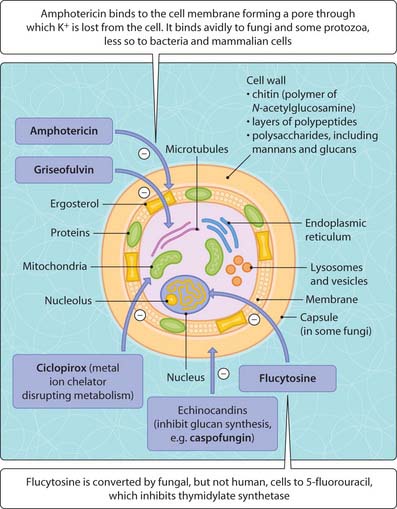49 Chemotherapy
antifungal agents
Unlike plants, fungi do not have chlorophyll and, therefore, have evolved to live as saprophytes or parasites and reproduce by spores. Fungi can be pathogenic (Candida albicans, Aspergillus fumigatus, Cryptococcus neoformans) or non-pathogenic (Saccharomyces cerevisiae). Yeasts are round and unicellular and multiply by budding or fission. There are also filamental forms made up of long tubes known as hyphae. A collection of hyphae is a mycelium, which is vegetative but if it is growing on a surface it can produce aerial extensions that carry spores. The dimorphic fungi can exist as yeasts or filaments and it is usually the yeast form that occurs in tissues and the filamentous form in the environment. Candida spp., however, form a mycelium in tissues. A number of drug classes have been developed that target fungal envelope (wall and membrane), microtubule assembly and DNA synthesis(Fig. 3.49.1). Fungal infections can damage tissues in several ways (Fig. 3.49.2).
Cell envelope
Polyene macrolides
The enzyme squalene 2,3-epoxidase is involved in the biosynthesis of ergosterol and its inhibition by allylamines leads to squalene accumulation in the cell wall and fungal death. Terbinafine and naftifine against filamentous fungi (e.g. moulds) and very few pathogenic yeasts. Terbinafine is orally active and because of its lipophilicity concentrates in the dermis and epidermis and is used for the topical treatment of ringworm athletes foot and onychomycosis (nail infection). Side-effects include nausea, loss of taste and allergic skin reactions.
Stay updated, free articles. Join our Telegram channel

Full access? Get Clinical Tree






